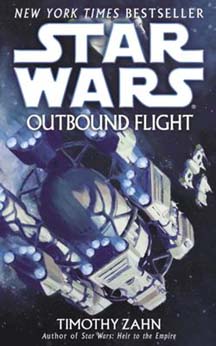“Outbound Flight” (2006) offers Expanded Universe fans the thrill of learning previously hinted-at “Star Wars” history. It’s similar to what “Episode I” offered to mainstream fans. Actually, as the “New York Times Bestseller” label on the front of the paperback attests, contradicting the party line of Disney, EU fans are no niche group. A lot of people had been looking forward to Timothy Zahn lifting the veil on the Outbound Flight Project throughout the 15 years since it was first mentioned in “Heir to the Empire.”
This masterwork – set exactly halfway between Episodes I and II — was worth the wait, as it not only tells the story of the Outbound Flight Project, but also the backstories of Grand Admiral Thrawn, Jedi Master Jorus C’baoth and other Zahn characters. Plus it peppers in some Anakin and Obi-Wan. And the way it ties together all eras of “Star Wars” lore is impressive.
Zahn notes in his 20th anniversary annotated edition of “Heir to the Empire,” on page 56, that Outbound Flight “was essentially a throwaway line, a way to confirm that this C’baoth was indeed a clone, as well as to underline Thrawn’s military capabilities. … I wish I’d known at the time that the project was going to grow to (its own novel). I would have given it a much cooler name.” Personally, I think the name perfectly evokes the idea of, as Pellaeon puts it on that page, “some sort of grand effort to extend the Republic’s authority outside the galaxy.” It’d be similar to a youngster knowing that man landed on the moon in 1969 but not knowing the details: He becomes hungry for knowledge as the universal human urge to explore (or at least to read about other humans’ explorations) kicks in.
In that same “Heir” conversation, Thrawn tells Pellaeon that he destroyed Outbound Flight, which presumably would take some of the fun out of “Outbound Flight” since we know its outcome. And 2004’s “Survivor’s Quest,” which finds Luke and Mara investigating the ruins of Outbound Flight, further blunted the mystery’s edginess. I’m not sure why the “Outbound Flight”/”Survivor’s Quest” duology was written backward (although it can be enjoyed in either reading order).
But Zahn certainly takes advantage of having full knowledge of the prequel trilogy, which had wrapped in 2005, and the “New Jedi Order” series, which had wrapped in 2003. Until this re-reading, I had forgotten that Zahn peppers in references to the Far Outsiders (the Yuuzhan Vong), and that Darth Sidious and his lackey, Kinman Doriana, mull the idea of stoking Far Outsider fears as part of Sidious’ power grab. Read in publication order, “Outbound Flight” is impressive for how it patches together holes in the grand narrative, but I think people reading the “Star Wars” novels in order will enjoy it more for the way it plants intrigue about Sidious’ machinations, Thrawn’s rise to prominence and the Yuuzhan Vong invasion.
Jorus C’baoth (I pronounce it “Ka-both” in my head, but apparently it’s “Suh-bay-oth”) is a scene stealer as we read about his descent to the dark side. It works as a nice parallel to Anakin, who admires C’baoth, much to Obi-Wan’s consternation. The potential misuse of Jedi power is a running theme in this novel. C’baoth’s Padawan, Lorana Jinzler, is certainly one of the good Jedi (the GFFA equivalent of “Not all cops are bad”), but even she gets a talking-to from her estranged brother, Dean (on page 187 of the paperback): “You Jedi think you’re perfect. You think you know what’s right for everyone and everything.”
Dean’s words – while not off base in regards to the order at large – are harsh when applied to his sister. But it must be noted that he sees the potential danger before she or the other Jedi do, and that danger is embodied in C’baoth. Despite ironically noting – when told rumors about someone named Darth Sidious — that the Sith are extinct, C’baoth spends most of “Outbound Flight” as a one-man freight train, using the strength of his personality and the threat of his Force powers to become the vessel’s de facto dictator, or (if we’re to be kind) a nanny-state mayor. After a dispute about whether C’baoth can forcefully adopt a passenger’s baby into Jedi training, he tells Obi-Wan on page 219 of the paperback that “guidance, in any form, seeks the other person’s best interests.” And a conversation on page 367 of the paperback illustrates that a slight tweaking of Jedi philosophy is all it takes to cross the thin brown-cloaked line from good to evil:
Thrawn: “I was told the role of the Jedi is to serve and defend.”
C’baoth: “You were told wrong. The role of a Jedi is to lead and guide, and destroy all threats.”
Although C’baoth is killed in this novel, his arc essentially continues when he returns in clone form as Joruus (two U’s) C’baoth, hurling dark-side lightning at his challengers, in the “Thrawn Trilogy.”
Chiss Expansionary Fleet Commander Thrawn is a trickier nut to crack, although he’s a blast to read about. In the “Thrawn Trilogy,” he’s the leader of a resurgent Empire looking to wipe out the New Republic. That’s hard to reconcile with this younger Thrawn, who is morally upstanding. I’m not saying Zahn writes him out of character, but rather that there are stories in between that explore the nuance of his philosophical transformation. (Zahn’s 1995’s short story “Mist Encounter” tells of an exiled Thrawn joining the Empire in order to provide military protection against potential threats to both the Empire and the Chiss on the border of the two territories.
But it doesn’t explain why he came to embrace the Empire’s authoritarian philosophy. Perhaps “Allegiance” and “Choices of One” cover this ground, but I can’t recall offhand.) Zahn is perhaps slightly smitten with his own creation, as even at this young age, the Chiss military genius makes all the right military and political moves while impressing the hell out of accidental human visitors (and audience surrogates) Car’das and Maris, the latter of whom is attracted to the blue-skinned, red-eyed alien – to the annoyance of her boyfriend, Qennto.
Keeping in character, Thrawn is a military aggressor in “Outbound Flight,” as he shoots first (going against Chiss moral dictates) and destroys a fleet of Vagaari, a nasty race of slavers who are the closest thing “Star Wars” has to “Firefly’s” Reavers. For crying out loud, the Vagaari put slaves in bubbles on the hulls of their ships to discourage enemies from firing on them! In this matchup, a reader can’t help but root for Thrawn, and even take his side when his higher-ups accuse him of pre-emptive war (something I generally oppose, but I give credit to Zahn for challenging my bias and making me say “Well, I guess sometimes it’s OK. If the bad guys are really, really evil.”).
But Thrawn is undeniably a good person in this novel. When Car’das says “Good-bye Commander, it’s been an honor knowing you,” Thrawn has earned the compliment. Thrawn delivers a blow to the evil Vagaari, and treats his three captive humans with respect, giving them the run of the Chiss ship and sharing mutual language lessons with them. And, despite his claim in “Heir,” he doesn’t deliver the killing blow to C’baoth and Outbound Flight: Doriana does that, unleashing Hiroshima-esque radiation bombs that were originally intended for the Vagaari. On the other hand, let’s not get too smitten with Thrawn: He doesn’t allow Car’das’s group to immediately go home. And it seems Doriana will eventually bring Thrawn into the Empire, which Thrawn embraces even though it seems to lack the nobility of the Chiss Expansionary Fleet.
Like I said, I need to delve into those in-between stories again at some point. But I’m not done with my exploration of the Outbound Flight Project quite yet, and I look forward to re-reading “Survivor’s Quest.”


